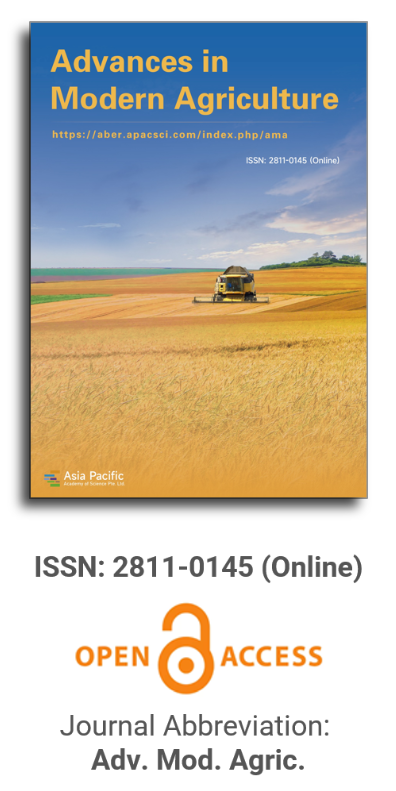


Agricultural inputs on rice yield: A case study of domestic rice production in Preah Vihear province, Cambodia
Vol 6, Issue 1, 2025
VIEWS - 2388 (Abstract)
Download PDF
Abstract
The key factors affecting domestic rice production in Preah Vihear Province, Cambodia, are investigated in this study. Cambodia’s economy depends largely on rice, which is both a main food and a major export. It helps Cambodia’s economy and food security. However, rice production is difficult due to lack of water, small farms, and geographical problems. Preah Vihear province is a key rice-producing region with hills and small farms. It helps increase income and sell rice to other countries with unique and famous rice seeds. To analyze the factors affecting domestic rice production in Preah Vihear, a statistical model known as ordinary least squares (OLS) will be used to examine the relationship between various input variables (costs) and rice yield. Data were gathered from a sample of 51 rice-farming households across five villages in Preah Vihear province. Additionally, both regression models indicated that herbicide costs were the most significant factor affecting rice yield, demonstrating high significance at the 5% level. This was closely followed by the price for renting rice harvesters and the total land area for rice production (ton). This study provides crucial information that can be used to develop targeted strategies to increase rice production and enhance the livelihoods of rural farmers. This will also empower stakeholders in the agricultural sector to propose campaigns that promote sustainable rice cultivation in local communities.
Keywords
References
- Royal Government of Cambodia. Royal Government of Cambodia. Pentagonal Strategy-Phase I for Growth, Employment, Equity, Efficiency and Sustainability: Building the Foundation Towards Realizing the Cambodia Vision 2050. In: Proceedings of the Royal Government of Cambodia of the Seventh Legislature of the National Assembly; August 2023.
- Sary S, Phearin B, Ravuth K, et al. Factors Affecting the Rice Yield During the Rainy Season Among Farmers in Southeastern Cambodia. Journal of Agricultural Science. 2024; 16(2): 1. doi: 10.5539/jas.v16n2p1
- Siek D, Xu SW, Wyu, et al. Impact of livestock Scale on Rice Production in Battambang of Cambodia. IOP Conference Series: Earth and Environmental Science. 2017; 86(1): 012019. doi: 10.1088/1755-1315/86/1/012019
- Ly S, Pynnonen LVJ, Sondergaard LM, et al. Cambodia economic update: Export revival and trade shifts - Strengthening Cambodia’s education system for future growth. World Bank Group; 2024.
- Ministry of Planning and Ministry of Agriculture, Forestry and Fisheries. NIS National Institute of Statistics. Cambodia Agricultural Survey 2020 Statistical Release. Ministry of Planning and Ministry of Agriculture, Forestry and Fisheries; 2020.
- NIS National Institute of Statistics. Cambodia Agricultural Survey 2021 Statistical Release. Ministry of Planning and Ministry of Agriculture, Forestry and Fisheries; 2023.
- Cramb R. White Gold: The Commercialisation of Rice Farming in the Lower Mekong Basin. Springer Nature Singapore; 2020.
- Savoeurn M, Brun JM. Contract Farming for organic paddy supply in Preah Vihear province. (Case Study), Support to the Commercialization of Cambodian Rice Project. Supreme National Economic Council (SNEC), Cambodia; 2018.
- Dayet A, Diepart JC, Castella JC, et al. Can organic rice certification curb the pressure of the agrarian transition in Cambodia? A farming system approach. Agricultural Systems. 2024; 217: 103953. doi: 10.1016/j.agsy.2024.103953
- Ministry of Planning and Ministry of Agriculture, Forestry and Fisheries. NIS National Institute of Statistics. Cambodia Inter-Censal Agriculture Survey 2019 (CIAS19). Ministry of Planning and Ministry of Agriculture, Forestry and Fisheries; 2019.
- NIS National Institute of Statistics. Cambodia Socio-Economic Survey 2021. National Institute of Statistics Ministry of Planning; 2022.
- TAA Travel Authentic Asia. Preah Vihear Province. Available online: https://www.travelauthenticasia.com/cambodia-destinations/preah-vihear-province.aspx (accessed on 30 August 2024).
- UNESCO. Cambodia celebrates 12 years of Preah Vihear Temple as a UNESCO World Heritage Site. Available online: https://whc.unesco.org/en/news/2162/ (accessed on 1 September 2024).
- WIPO World Intellectual Property Organization. Cambodia’s Certified Organic Preah Vihear Rice: "A Collective Mark Raises Hopes of Better Revenue for Organic Rice Producers in Cambodia". Available online: https://www.wipo.int/en/web/ip-advantage/w/stories/cambodia-s-certified-organic-preah-vihear-rice (accessed on 28 July 2024).
- Sevea. Climate Resilient Agriculture Assessment. Sevea; 2022.
- Fox J. Applied regression analysis and generalized linear models. Sage publications; 2015.
- Hu Z. Introduction to modern econometrics using Stata/EViews. Beijing, China: Renmin University Press; 2010.
- Darith S, Eav L, Kim H. Profitability Analysis of Long Coriander Crop Share by Small-Scale Producers in Battambang, Cambodia. International Journal of Agricultural Economics. 2024; 9(4): 210-217. doi: 10.11648/j.ijae.20240904.13
- Hutcheson G, Hutcheson G. Ordinary Least-Squares Regression. The SAGE Dictionary of Quantitative Management Research; 2011.
- Stock JH, Watson MW. Introduction to econometrics, 3rd ed. Pearson Addison-Wesley; 2015.
- Siek D, Emmsethakar S, Yu W, et al. Empirical Analysis on Economic Sustainable of Rice Rain-Fed Area in Rural Cambodia. American Journal of Agriculture and Forestry. 2024; 12(3): 217-222. doi: 10.11648/j.ajaf.20241203.18
- Wooldridge JM. Introductory Econometrics: A Modern Approach, 4th ed. Cengage Learning; 2009.
- Darith S, Eav L. Multi-Regression Modeling of Harvest Income in Smallholder Long Coriander Production: Insights from Battambang, Cambodia. American Journal of Agriculture and Forestry. 2024; 12(4): 307-316. doi: 10.11648/j.ajaf.20241204.18
- Darith S, Eav LK, Ngath S, et al. Factors affecting rice domestic production output in Preah Vihear province, Cambodia: A study using OLS regression model. International Journal of Sustainable Agricultural Research. 2024; 11(4): 125-137.
- Calha I, Oliveira M de F, Reis P. Weed Management Challenges in Rice Cultivation in the Context of Pesticide Use Reduction: A Survey Approach. Sustainability. 2022; 15(1): 244. doi: 10.3390/su15010244
- Mohler CL, Johnson SE. Crop rotation on organic farms: A planning manual. Sustainable Agriculture Research and Education (SARE) and Plant and Life Sciences Publishing (PALS); 2009.
- Adamopoulos T. Transportation costs, agricultural productivity, and cross‐country income differences*. International Economic Review. 2011; 52(2): 489-521. doi: 10.1111/j.1468-2354.2011.00636.x
- Karayalcin C, Pintea M. The role of productivity, transportation costs, and barriers to intersectoral mobility in structural transformation. Economic Modelling. 2022; 108: 105759. doi: 10.1016/j.econmod.2022.105759
- Ruhinduka RD, Alem Y, Eggert H, et al. Smallholder rice farmers’ post-harvest decisions: preferences and structural factors. European Review of Agricultural Economics. 2020; 47(4): 1587-1620. doi: 10.1093/erae/jbz052
- Heerink N, Atsma P, Fosu KY. Farmers’ transport costs and agricultural production in Ghana. In: Sustainable food security in West Africa. Boston, MA: Springer US; 1997. pp. 234-251.
- Sokvibol K, Hua L, Linvolak P. Technical Efficiency Analysis of Cambodian Household’s Rice Production. Global Journal of Human-Social Science. 2016; 16(3): 33-44.
- Jourdain D, Lairez J, Striffler B, et al. Farmers’ preference for cropping systems and the development of sustainable intensification: a choice experiment approach. Review of Agricultural, Food and Environmental Studies. 2020; 101(4): 417-437. doi: 10.1007/s41130-020-00100-4
- Yu B, Diao X. Cambodia’s agricultural strategy: Future development options for the rice sector. In: Proceedings of the Cambodia Food Security and Agricultural Policy Stocktaking Roundtable; 4 November 2010; Phnom Penh, Cambodia.
- Smith D, Hornbuckle J. A review on rice productivity in Cambodia and water use measurement using direct and indirect methods on a dry season rice crop. Sustainable Agriculture Flagship, Commonwealth Scientific and Industrial Research Organization, Australia; 2013.
- ADB Asian Development Bank. The Rice Situation in Cambodia, Technical Assistance Consultant’s Report of Asian Development Bank (ADB). Asian Development Bank; 2012.
- ADB Asian Development Bank. Improving rice production and commercialization in Cambodia. Printed in the Philippines; 2014.
- ADB Asian Development Bank. Cambodia Agriculture, Natural Resources, and Rural Development Sector Assessment, Strategy, and Road Map. ADB Asian Development Bank; 2021.
- Kumar D, Kalita P. Reducing Postharvest Losses during Storage of Grain Crops to Strengthen Food Security in Developing Countries. Foods. 2017; 6(1): 8. doi: 10.3390/foods6010008
Supporting Agencies
Copyright (c) 2025 Siek Darith, Lim Kim Eav, Loeurng Chymann, Leng Channy, Din Chamroeun, Yun Chihouy, Siengly Hang
License URL: https://creativecommons.org/licenses/by/4.0/

This site is licensed under a Creative Commons Attribution 4.0 International License (CC BY 4.0).

Prof. Zhengjun Qiu
Zhejiang University, China

Cheng Sun
Academician of World Academy of Productivity Science; Executive Chairman, World Confederation of Productivity Science China Chapter, China
Indexing & Archiving
In the realm of modern agriculture, the integration of cutting-edge technologies is revolutionizing the way we approach sustainable farming practices. A recent study published in Advances in Modern Agriculture titled "Classification of cotton water stress using convolutional neural networks and UAV-based RGB imagery" has garnered significant attention for its innovative approach to precision irrigation management. Conducted by researchers from Institute of Data Science and the AgriLife Research and Extension Center of Texas A&M University (authors's information is below). This study introduces a novel method for classifying cotton water stress using unmanned aerial vehicles (UAVs) and convolutional neural networks (CNNs), offering a powerful solution for optimizing water use in agriculture.
Modern agricultural technology is evolving rapidly, with scientists collaborating with leading agricultural enterprises to develop intelligent management practices. These practices utilize advanced systems that provide tailored fertilization and treatment options for large-scale land management.
This journal values human initiative and intelligence, and the employment of AI technologies to write papers that replace the human mind is expressly prohibited. When there is a suspicious submission that uses AI tools to quickly piece together and generate research results, the editorial board of the journal will reject the article, and all journals under the publisher's umbrella will prohibit all authors from submitting their articles.
Readers and authors are asked to exercise caution and strictly adhere to the journal's policy regarding the usage of Artificial Intelligence Generated Content (AIGC) tools.
Asia Pacific Academy of Science Pte. Ltd. (APACSCI) specializes in international journal publishing. APACSCI adopts the open access publishing model and provides an important communication bridge for academic groups whose interest fields include engineering, technology, medicine, computer, mathematics, agriculture and forestry, and environment.



.jpg)
.jpg)

.jpg)
